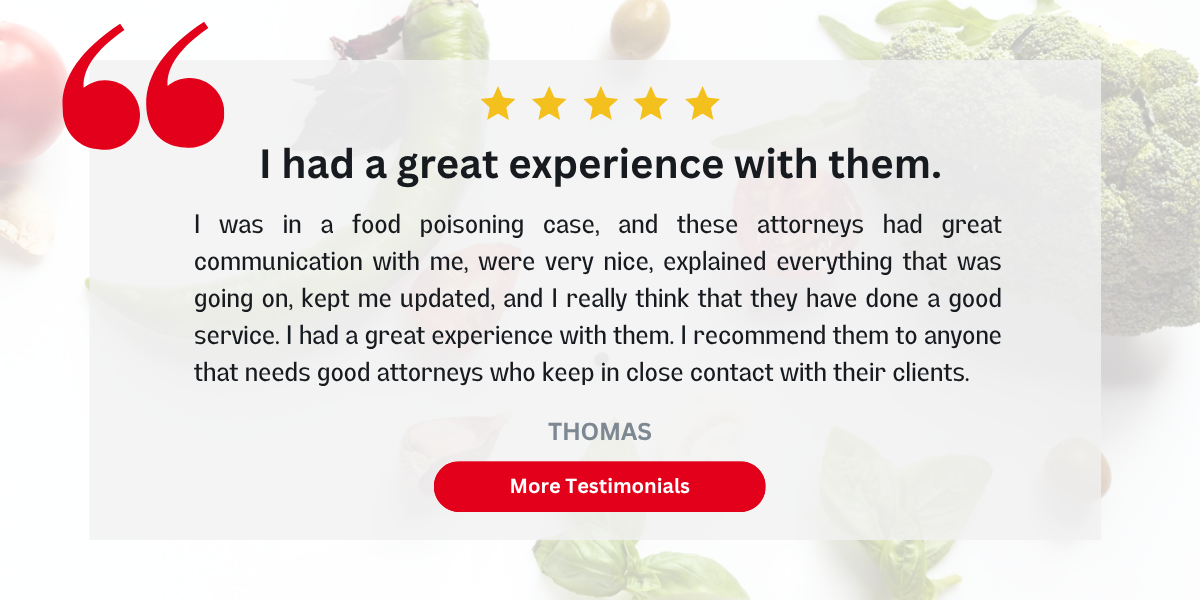San Diego Salmonella Attorney
Salmonella outbreaks occur when the bacteria contaminate food, water, or environments, leading to widespread infection. The bacteria can be introduced at various stages of the food supply chain, from farm to table, through poor hygiene practices, inadequate cooking, and cross-contamination.
Food Production and Processing
- Farm Level: Contamination can occur at the farm level through infected animals (especially poultry, cattle, and pigs) and waste products. Contaminated water and feed can also introduce Salmonella to livestock.
- Processing Plants: During slaughtering and processing, Salmonella can spread from the intestines of animals to meat and poultry products. Inadequate cleaning of equipment and facilities can facilitate cross-contamination between batches.
- Raw Ingredients: Contaminated raw ingredients, such as eggs or milk, can introduce Salmonella into processed foods. This is particularly problematic if the food is not cooked thoroughly before consumption.
Distribution and Storage
- Temperature Abuse: Improper storage temperatures can allow Salmonella to multiply. For example, not keeping perishable foods like meat, eggs, and dairy products refrigerated can promote bacterial growth.
- Cross-Contamination: During transportation and storage, improper handling can lead to cross-contamination between contaminated and uncontaminated foods.
Food Preparation and Handling:
- Home and Restaurants: Poor hygiene practices, such as not washing hands after handling raw meat, can transfer Salmonella to other foods. Using the same cutting boards or utensils for raw and cooked foods without proper cleaning can also spread the bacteria.
- Mass Catering Events: Large-scale food preparation for events or institutional settings (like schools, hospitals, and cafeterias) can amplify the impact of contamination if hygiene practices are not followed rigorously.
Environmental Factors:
- Water Contamination: Outbreaks can occur if water sources are contaminated with Salmonella and used for drinking, irrigation, or washing food products. Floods or sewage leaks can introduce bacteria into water supplies.
- Soil Contamination: Fruits and vegetables can become contaminated through contact with soil containing Salmonella, often from manure or contaminated water for irrigation.

How to Prevent a Salmonella Outbreak
Preventing a Salmonella outbreak involves implementing stringent food safety measures and proper hygiene practices at every stage of the food supply chain, from farm to table. Here are key steps to prevent a Salmonella outbreak:
Farm Level
Farm workers have a duty of care to ensure that their products do not transmit salmonella. They can do this by:
- Healthy Livestock Management:
- Regular health monitoring and veterinary care for animals to detect and treat infections early.
- Implementing biosecurity measures to prevent the introduction and spread of Salmonella among livestock.
- Using high-quality feed and clean water to minimize contamination risks.
- Sanitation:
- Maintaining clean and sanitized facilities, equipment, and vehicles used for transporting animals and feed.
- Proper disposal of animal waste to prevent contamination of water sources and crops.
Food Processing and Manufacturing
This is another stage in the food chain that is responsible for checking for and preventing the spread of salmonella. They do this using:
- Strict Hygiene Protocols:
- Ensuring that all employees follow rigorous handwashing and personal hygiene practices.
- Regularly clean and sanitize equipment, surfaces, and utensils used in food processing and preparation.
- Temperature Control:
- Keeping raw and perishable foods at appropriate temperatures to prevent bacterial growth.
- Cooking foods, especially poultry and eggs, to safe internal temperatures to kill any present bacteria.
- Cross-Contamination Prevention:
- Separate equipment and surfaces are used for raw and cooked foods.
- Implementing proper food handling procedures to avoid cross-contamination between different food items.
Retail and Food Service
Another step in the food chain is the food service industry, which must ensure that food poisoning isn’t inadvertently given to its customers. They can do this through:
- Employee Training:
- Educating employees on the importance of food safety practices, including proper handwashing, cooking, and storage procedures.
- Regularly updating training to keep up with current food safety standards and practices.
- Food Storage and Handling:
- Storing food at safe temperatures and ensuring that refrigeration units are functioning correctly.
- Using FIFO (first in, first out) inventory management to ensure older products are used before newer ones.
San Diego Salmonella Statistics
In 2021, 585 Salmonella cases were reported in San Diego, and 25% of those affected had to be hospitalized. Eating out was the highest reported risk factor for Salmonella in 2017, 2018, and 2021.
Between 2017 and 2021, the San Diego Salmonella incidence rate per 100,000 people was consistently higher than the rates for California and the United States as a whole.
|
2017 |
2018 |
2019 |
2020 |
2021 |
| San Diego |
17.4 |
23.8 |
19.8 |
14.8 |
17.6 |
| California |
13.7 |
15.9 |
14.5 |
10.1 |
11.6 |
| United States |
16.8 |
18.9 |
18.0 |
13.4 |
11.5 |
We Can Help

Suffering from Salmonella? You may be entitled to compensation. Reach out to The Lange Law Firm at (833) 330-3663 or message us online for a free consultation. We’ll thoroughly investigate your case and help you seek the justice you deserve.